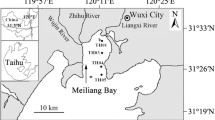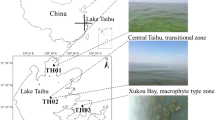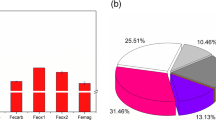Abstract
Purpose
Fe(III) transformation to Fe(II) via the nitrate-dependent iron oxidation process, occurring in anoxic sediments, has an important role in the nitrogen cycle. In this study, laboratory experiments were performed to investigate the denitrification properties driven by nitrate-dependent iron oxidation.
Materials and methods
A 30-day incubation study of sediments and overlying water from Lake Moshui in Wuhan, China, was conducted in an anoxic condition. The nitrate reduction during the incubation was evaluated by the N2O emission and various forms of nitrogen in the overlying water. The denitrification enzyme activity and abundance of nitrate-dependent Fe(II)-oxidising bacteria were determined periodically, and their correlations with nitrogen and iron were analysed to illustrate the denitrification characteristics linked to Fe(II) oxidation in sediments.
Results and discussion
After the Fe(II) and nitrate input, the decrease of Fe(II) and nitrate concentrations was accompanied by an increase in nitrite and N2O production. The contribution of Fe(II) oxidation to the nitrate reduction accounted for 27.7% at the end of the incubation, and the rate of Fe(II) decrease was significantly correlated (P < 0.05) with the production of N2O. In addition, a positive correlation between denitrification enzyme activity and nitrate concentrations was observed. During incubation, the abundance of nitrate-dependent Fe(II)-oxidising bacteria in the sediment ranged from 1.1 × 105 cell g−1 wet sediment to 1.4 × 106 cell g−1 wet sediment, and increased with the increase of Fe(II) input concentration. The nitrate reduction coupled with Fe(II) oxidation was mainly mediated by microbial processes.
Conclusions
Sediment denitrification was enhanced with increasing Fe(II) concentrations, and Fe(II) may play an important role in regulating nitrogen transformation in freshwater lakes.








Similar content being viewed by others
References
Babbin AR, Keil RG, Devol AH, Ward BB (2014) Organic matter stoichiometry, flux, and oxygen control nitrogen loss in the ocean. Science 344:406–408
Beller HR, Zhou P, Legler TC, Chakicherla A, Kane S, Letain TE, O’Day PA (2013) Genome-enabled studies of anaerobic, nitrate-dependent iron oxidation in the chemolithoautotrophic bacterium Thiobacillus denitrificans. Front Microbiol 4:249
Bonnefoy V, Holmes DS (2012) Genomic insights into microbial iron oxidation and iron uptake strategies in extremely acidic environments. Environ Microbiol 14:1597–1611
Bruce RA, Achenbach LA, Coates JD (1999) Reduction of (per)chlorate by a novel organism isolated from paper mill waste. Environ Microbiol 1:319–329
Burgin AJ, Hamilton SK (2007) Have we overemphasized the role of denitrification in aquatic ecosystems? A review of nitrate removal pathways. Front Ecol Environ 5:89–96
Canfield DE, Stewart FJ, Thamdrup B, De Brabandere L, Dalsgaard T, Delong EF, Revsbech NP, Ulloa O (2010) A cryptic sulfur cycle in oxygen-minimum-zone waters off the Chilean coast. Science 330:1375–1378
Cao YP, Green PG, Holden PA (2008) Microbial community composition and denitrifying enzyme activities in salt marsh sediments. Appl Environ Microbiol 74:7585–7595
Cayuela ML, van Zwieten L, Singh BP, Jeffery S, Roig A, Sánchez-Monedero MA (2014) Biochar’s role in mitigating soil nitrous oxide emissions: a review and meta-analysis. Agric Ecosyst Environ 191:5–16
Chakraborty A, Picardal F (2013) Induction of nitrate-dependent Fe(II) oxidation by Fe(II) in Dechloromonas sp. strain UWNR4 and Acidovorax sp. strain 2AN. Appl Environ Microbiol 79:748–752
Chaudhuri SK, Lack JG, Coates JD (2001) Biogenic magnetite formation through anaerobic biooxidation of Fe(II). Appl Environ Microbiol 67:2844–2848
Cochran WG (1950) Estimation of bacterial densities by means of the “most probable number”. Biometrics 6:105–116
Dai JW, He SB, Zhou WL, Huang JC, Chen S, Zeng XH (2018) Integrated ecological floating bed treating wastewater treatment plant. Environ Sci Pollut Res 25:18793–18801
Dubinina GA, Sorokina AY (2014) Neutrophilic lithotrophic iron-oxidizing prokaryotes and their role in the biogeochemical processes of the iron cycle. Microbiology 83:1–14
Dunne EJ, Coveney MF, Marzolf ER, Hoge VR, Conrow R, Naleway R, Lowe EF, Battoe LE, Inglett PW (2013) Nitrogen dynamics of a large-scale constructed wetland used to remove excess nitrogen from eutrophic lake water. Ecol Eng 61:224–234
Gao J, Hou LJ, Zheng YL, Liu M, Yin GY, Li XF, Lin XB, Yu CD, Wang R, Jiang XF, Sun XR (2016) nirS-Encoding denitrifier community composition, distribution, and abundance along the coastal wetlands of China. Appl Microbiol Biotechnol 100:8573–8582
Gardner LM, White JR (2010) Denitrification enzyme activity as an indicator of nitrate movement through a diversion wetland. Soil Sci Soc Am J 74:1037–1047
Han HJ, Lu XX, Burger DF, Joshi UM, Zhang L (2014) Nitrogen dynamics at the sediment–water interface in a tropical reservoir. Ecol Eng 73:146–153
Hauck S, Benz M, Brune A, Schink B (2001) Ferrous iron oxidation by denitrifying bacteria in profundal sediments of a deep lake (Lake Constance). FEMS Microbiol Ecol 37:127–134
Hayakawa A, Hatakeyama M, Asano R, Ishikawa Y, Hidaka S (2013) Nitrate reduction coupled with pyrite oxidation in the surface sediments of a sulfide-rich ecosystem. J Geophys Res-Biogeo 118:639–649
Hegler F, Posth NR, Jiang J, Kappler A (2008) Physiology of phototrophic iron(II)-oxidizing bacteria: implications for modern and ancient environments. FEMS Microbiol Ecol 66:250–260
Hibiya K, Terada A, Tsuneda S, Hirata A (2003) Simultaneous nitrification and denitrification by controlling vertical and horizontal microenvironment in a membrane-aerated biofilm reactor. J Biotechnol 100:23–32
Hu M, Chen PC, Sun WM, Li FB, Cui JH (2017) A novel organotrophic nitrate-reducing Fe(II)-oxidizing bacterium isolated from paddy soil and draft genome sequencing indicate its metabolic versatility. RSC Adv 7:56611–56620
Hu M, Chen PC, Sun WM, Li FB, Cui JH (2019) Physiological and genomic characterization of a nitrate-reducing Fe(II)-oxidizing bacterium isolated from paddy soil. Geomicrobiol J 36:433–442
Jørgensen CJ, Jacobsen OS, Elberling B, Aamand J (2009) Microbial oxidation of pyrite coupled to nitrate reduction in anoxic groundwater sediment. Environ Sci Technol 43:4851–4857
Kampschreur MJ, Kleerebezem R, de Vet WWJM, van Loosdrecht MCM (2011) Reduced iron induced nitric oxide and nitrous oxide emission. Water Res 45:5945–5952
Kesserű P, Kiss I, Bihari Z, Polyák B (2002) Investigation of the denitrification activity of immobilized Pseudomonas butanovora cells in the presence of different organic substrates. Water Res 36:1565–1571
Krepski ST, Hanson TE, Chan CS (2012) Isolation and characterization of a novel biomineral stalk-forming iron-oxidizing bacterium from a circumneutral groundwater seep. Environ Microbiol 14:1671–1680
Lam P, Kuypers MMM (2011) Microbial nitrogen cycling processes in oxygen minimum zones. Annu Rev Mar Sci 3:317–345
Laufer K, Nordhoff M, Røy H, Schmidt C, Behrens S, Jørgensen BB, Kappler A (2015) Coexistence of microaerophilic, nitrate-reducing, and phototrophic Fe(II) oxidizers and Fe(III) reducers in coastal marine sediment. Appl Environ Microbiol 82:1433–1447
Laufer K, Byrne JM, Glombitza C, Schmidt C, Jorgensen BB, Kappler A (2016) Anaerobic microbial Fe(II) oxidation and Fe(III) reduction in coastal marine sediments controlled by organic carbon content. Environ Microbiol 18:3159–3174
Li S, Li XM, Li FB (2018) Fe(II) oxidation and nitrate reduction by a denitrifying bacterium, Pseudomonas stutzeri LS-2, isolated from paddy soil. J Soils Sediments 18:1668–1678
Melton ED, Swanner ED, Behrens S, Schmidt C, Kappler A (2014) The interplay of microbially mediated and abiotic reactions in the biogeochemical Fe cycle. Nat Rev Microbiol 12:797–808
Nizzoli D, Bartoli M, Azzoni R, Longhi D, Castaldelli G, Viaroli P (2018) Denitrification in a meromictic lake and its relevance to nitrogen flows within a moderately impacted forested catchment. Biogeochemistry 137:143–161
Pyzola S (2013) Nitrate reduction coupled to iron(II) oxidation and manganese(II) in an agricultural soil. Dissertation. University of Kentucky
Robertson EK, Thamdrup B (2017) The fate of nitrogen is linked to iron(II) availability in a freshwater lake sediment. Geochim Cosmochim Acta 205:84–99
Rowe AR, Chellamuthu P, Lam B, Okamoto A, Nealson KH (2014) Marine sediments microbes capable of electrode oxidation as a surrogate for lithotrophic insoluble substrate metabolism. Front Microbiol 5:784
Sayama M, Risgaard-Petersen N, Nielsen LP, Fossing H, Christensen PB (2005) Impact of bacterial NO3− transport on sediment biogeochemistry. Appl Environ Microbiol 71:7575–7577
Scholz F, Löscher CR, Fiskal A, Sommer S, Hensen C, Lomnitz U, Wuttig K, Göttlicher J, Kossel E, Steininger R, Canfield DE (2016) Nitrate-dependent iron oxidation limits iron transport in anoxic ocean regions. Earth Planet Sci Lett 454:272–281
Schubert CJ, Durisch-Kaiser E, Wehrli B, Thamdrup B, Lam P, Kuypers MMM (2006) Anaerobic ammonium oxidation in a tropical freshwater system (Lake Tanganyika). Environ Microbiol 8:1857–1863
Senn DB, Hemond HF (2002) Nitrate controls on iron and arsenic in an urban lake. Science 296:2373–2376
Shelobolina E, Konishi H, Xu HF, Benzine J, Xiong MY, Wu T, Blothe M, Roden E (2012) Isolation of phyllosilicate-iron redox cycling microorganisms from an illite-smectite rich hydromorphic soil. Front Microbiol 3:134
Silva LCF, Lima HS, Sartoratto A, de Sousa MP, Torres APR, de Souza RS, de Paula SO, de Oliveira VM, da Silva CC (2018) Effect of salinity in heterotrophic nitrification/aerobic denitrification performed by acclimated microbiota from oil-produced water biological treatment system. Int Biodeterior Biodegradation 130:1–7
Šimek M, Jı́šová L, Hopkins DW (2002) What is the so-called optimum pH for denitrification in soil? Soil Biol Biochem 34:1227–1234
Smith MS, Tiedje JM (1979) Phases of denitrification hollowing oxygen depletion in soil. Soil Biol Biochem 11:261–267
State Environmental Protection Administration of the People’s Republic of China (2002) Determination methods for examination of water and wastewater, fourth ed. China Environmental Science Press, Beijing
Straub KL, Buchholz-Cleven BEE (1998) Enumeration and detection of anaerobic ferrous iron-oxidizing, nitrate-reducing bacteria from diverse European sediments. Appl Environ Microbiol 64:4846–4856
Straub KL, Benz M, Schink B, Widdel F (1996) Anaerobic, nitrate-dependent microbial oxidation of ferrous iron. Appl Environ Microbiol 62:1458–1460
Tiedje JM (1994) Denitrifiers. In: Bottomley PS, Angle JS, Weaver RW (eds) Methods of soil analysis, Part 2. Microbiological and biochemical properties. Soil Science Society of America Press, Madison, pp 253–254
Valderrama JC (1981) The simultaneous analysis of total nitrogen and phosphorus in natural waters. Mar Chem 10:109–122
Viollier E, Inglett PW, Hunter K, Roychoudhury AN, Cappellen PV (2000) The ferrozine method revisited: Fe(II)/Fe(III) determination in natural waters. Appl Geochem 15:785–790
Wang ML, Hu RG, Zhao JS, Kuzyakov Y, Liu SR (2016) Iron oxidation affects nitrous oxide emissions via donating electrons to denitrification in paddy soils. Geoderma 271:173–180
Weber KA, Achenbach LA, Coates JD (2006a) Microorganisms pumping iron: anaerobic microbial iron oxidation and reduction. Nat Rev Microbiol 4:752–764
Weber KA, Pollock J, Cole KA, O’Connor SM, Achenbach LA, Coates JD (2006b) Anaerobic nitrate-dependent iron(II) bio-oxidation by a novel lithoautotrophic betaproteobacterium, strain 2002. Appl Environ Microbiol 72:686–694
Weber KA, Urrutia MM, Churchill PF, Kukkadapu RK, Roden EE (2006c) Anaerobic redox cycling of iron by freshwater sediment microorganisms. Environ Microbiol 8:100–113
Weber KA, Hedrick DB, Peacock AD, Thrash JC, White DC, Achenbach LA, Coates JD (2009) Physiological and taxonomic description of the novel autotrophic, metal oxidizing bacterium, Pseudogulbenkiania sp. strain 2002. Appl Microbiol Biotechnol 83:555–565
Wenk CB, Blees J, Zopfi J, Veronesi M, Bourbonnais A, Schubert CJ, Niemann H, Lehmann MF (2013) Anaerobic ammonium oxidation (anammox) bacteria and sulfide-dependent denitrifiers coexist in the water column of a meromictic south-alpine lake. Limnol Oceanogr 58:1–12
Wu GX, Zhai XF, Jiang CG, Guan YT (2013) Effect of ammonium on nitrous oxide emission during denitrification with different electron donors. J Environ Sci 25:1131–1138
Wunderlich A, Meckenstock R, Einsiedl F (2012) Effect of different carbon substrates on nitrate stable isotope fractionation during microbial denitrification. Environ Sci Technol 46:4861–4868
Yang XA, Huang S, Wu QH, Zhang RD (2012) Nitrate reduction coupled with microbial oxidation of sulfide in river sediment. J Soils Sediments 12:1435–1444
Yu JH, Fan CX, Zhong JC, Zhang L, Zhang L, Wang CH, Yao XL (2016) Effects of sediment dredging on nitrogen cycling in Lake Taihu, China: insight from mass balance based on a 2-year field study. Environ Sci Pollut Res 23:3871–3883
Zhang HH, Feng J, Chen SN, Zhao ZF, Li BQ, Wang Y, Jia JY, Li SL, Wang Y, Yan MM, Lu KY, Hao HY (2019) Geographical patterns of nirS gene abundance and nirS-type denitrifying bacterial community associated with activated sludge from different wastewater treatment plants. Microb Ecol 77:304–316
Funding
This research was supported by National Key R & D Program of China (No. 2017YFC0505305).
Author information
Authors and Affiliations
Corresponding author
Additional information
Responsible editor: Haihan Zhang
Publisher’s note
Springer Nature remains neutral with regard to jurisdictional claims in published maps and institutional affiliations.
Rights and permissions
About this article
Cite this article
Cheng, B., Hua, Y., Zhao, J. et al. Nitrogen transformation mediated by nitrate-dependent iron oxidation in anoxic freshwater. J Soils Sediments 20, 1087–1096 (2020). https://doi.org/10.1007/s11368-019-02461-w
Received:
Accepted:
Published:
Issue Date:
DOI: https://doi.org/10.1007/s11368-019-02461-w




